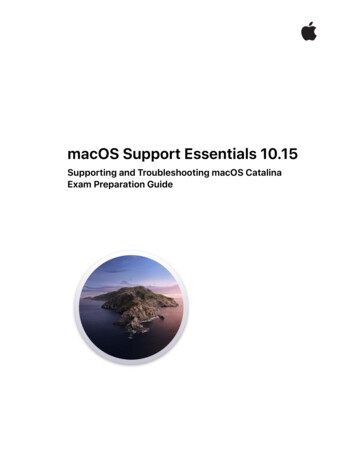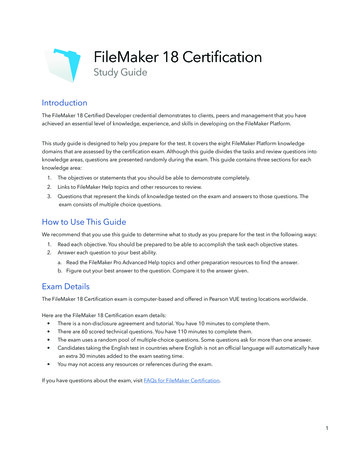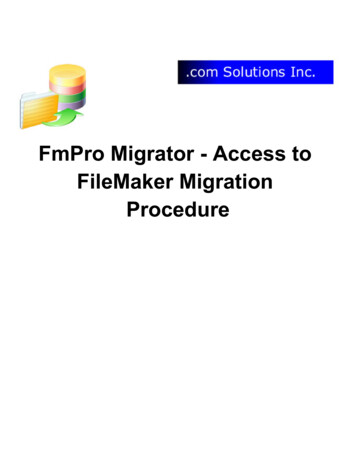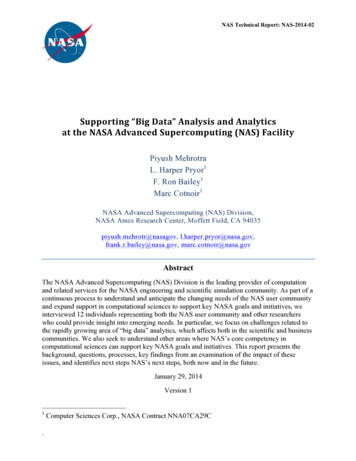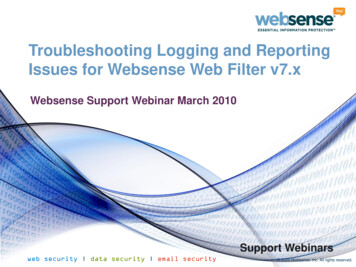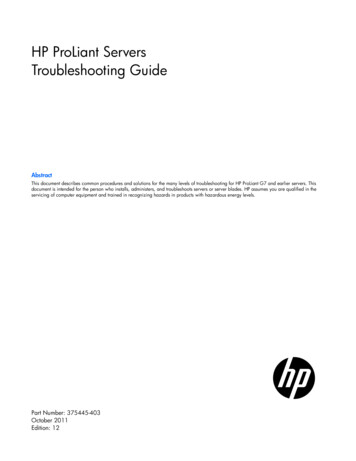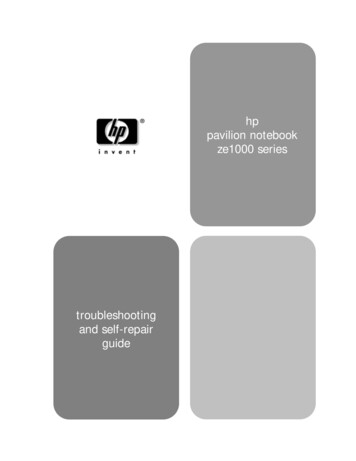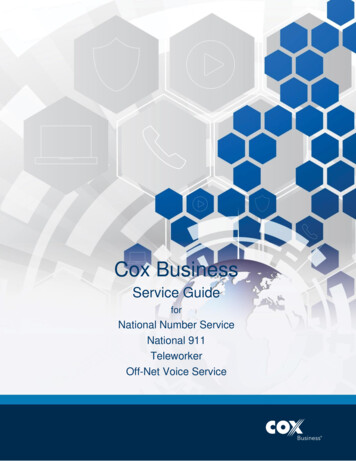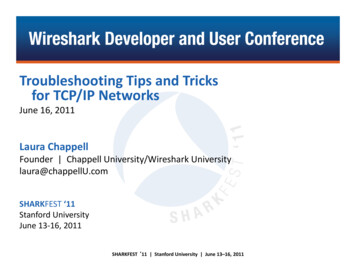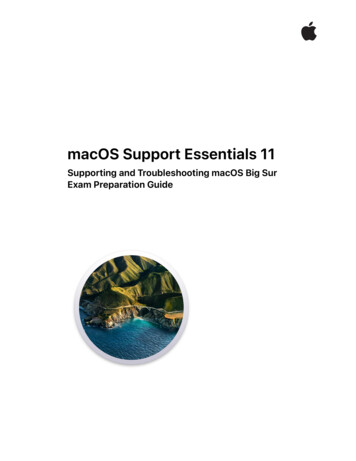
Transcription
macOS Support Essentials 11rSupporting and Troubleshooting macOS Big SuExam Preparation Guide
ContentsAbout the ACSP certification.6Taking the exam .6Preparing for the exam .7Exam details .7Lesson 1—Introduction to macOS .8Goals.8Review questions .8Answers.8Lesson 2—Update, Upgrade, Reinstall macOS .9Goals .9Review questions .9Answers .10Lesson 3—Set Up Your Mac .11Goals .11Review questions .11Answers .11Lesson 4—Use the Command Line .11Goals .11Review questions .11Answers .12Lesson 5—Use macOS Recovery .13Goals .13Answers .13Lesson 6—Update macOS .14Goals .14Review questions .15Answers .15Lesson 7—Manage User Accounts .16macOS Support Essentials 11Exam Preparation Guide2
Goals .16Review questions .16Answers .16Lesson 8—Manage User Home Folders .17Goals .17Review questions .17Answers .17Lesson 9—Manage Security and Privacy .18Goals .18Review questions .18Answers .19Lesson 10—Manage Password Changes .20Goals .20Review questions .20Answers .20Lesson 11—Manage File Systems and Storage .22Goals .22Review questions .22Answers .22Lesson 12—Manage FileVault .23Goals .23Review questions .23Answers .23Lesson 13—Manage Permissions and Sharing .24Goals .24Review questions .24Answers .24Lesson 14—Use Hidden Items, Shortcuts, and File Archives .25Goals .25Review questions .25macOS Support Essentials 11Exam Preparation Guide3
Answers .25Lesson 15—Manage System Resources .26Goals .26Review questions .26Answers .26Lesson 16—Use Metadata, Siri, and Spotlight .28Goals .28Review questions .28Answers .28Lesson 17—Manage Time Machine .29Goals .29Review questions .29Answers .29Lesson 18—Install Apps .30Goals .30Review questions .30Answers .30Lesson 19—Manage Files .31Goals .31Review questions .31Answers .31Lesson 20—Manage and Troubleshoot Apps.33Goals .33Review questions .33Answers .33Lesson 21—Manage Basic Network Settings .35Goals .35Review questions .35Answers .35Lesson 22—Manage Advanced Network Settings .36macOS Support Essentials 11Exam Preparation Guide4
Goals .36Review questions .36Answers .36Lesson 23—Troubleshoot Network Issues .37Goals .37Review questions .37Answers .38Lesson 24—Manage Network Services .39Goals .39Review questions .39Answers .39Lesson 25—Manage Host Sharing and Personal Firewall .40Goals .40Review questions .40Answers .41Lesson 26—Troubleshoot Peripherals .42Goals .42Review questions .42Answers .42Lesson 27—Manage Printers and Scanners .43Goals .43Review questions .43Answers .43Lesson 28—Troubleshoot Startup and System Issues.44Goals .44Review questions .44Answers .44macOS Support Essentials 11Exam Preparation Guide5
Becoming an Apple Certified SupportProfessionalThe Apple Certified Support Professional (ACSP) certification is for the help desk professional, technicalcoordinator, or power user who manages networks or provides technical support for Mac users. This examverifies that you understand the key concepts covered in this document and in the macOS SupportEssentials 11 book and related materials. If you pass the exam, you earn the ACSP 11 certification. For moreinformation, visit the Training and Certification website.About the ACSP certificationWith the ACSP certification, you differentiate yourself as a skilled professional, gain a competitive edge inan evolving job market, and benefit from the power of the Apple brand.When you pass the exam, an email notifies you about how you receive your Apple certificate along withinstructions on how to order a framed version.Taking the examYou can take this exam online through the Pearson OnVUE online proctoring system. You take your examfrom your home or office, with an online proctor and webcam. Watch this brief video to learn more aboutthe Pearson OnVUE experience. You need a private space and current, government-issued identification totake the exam.To take the exam online, do the following: Sign in to or create an account in the Apple Certification Records System (ACRS) using your Apple ID.Make sure that your name in your ACRS account matches your name on your government-issuedidentification. Click “Take an Exam” to pay for and schedule your exam. At the scheduled time, sign in to ACRS, click “Take an Exam,” and check in with the proctor.After you complete the exam, Pearson emails your exam score to you6.macOS Support Essentials 11Exam Preparation Guide
Preparing for the examComplete the following to prepare for the exam: Study the Apple Pro Training Series book macOS Support Essentials 11: Supporting and TroubleshootingmacOS Big Sur by Arek Dreyer and Adam Karneboge. Questions on the exam can come from the materialpresented in the book's reference and exercise sections or relevant Apple support articles. Gain experience with macOS. The best way to build expertise with technology is to use it. Spend sometime getting familiar with the technology and practicing the exercises. Read this guide and practice by completing the sample tasks and answering the review questions. Thisguide helps you study and prepare—whether you’ve learned about macOS Big Sur from the book or onthe job. Consult some of the many third-party reference, troubleshooting, and online tutorials for users of variouslevels, from novice to power user. Post any questions you have to one of the macOS Support Communities that Apple hosts.Exam details macOS Support Essentials 11 End User Exam (9L0-453) This exam costs about 250 USD. Certification exam prices are subject to change and may vary based oncurrency values. In some countries and regions, additional taxes may apply. The exam contains about 100 scored technical questions. You have 150 minutes to complete them. A passing score is 72 percent. Scores aren’t rounded. The exam uses a random pool of multiple-choice and interactive-media questions. You may not access any resources or references during the exam. For more information about Apple technical exams, visit the Frequently Asked Questions page.macOS Support Essentials 11Exam Preparation Guide7
Part One: Installation and ConfigurationLesson 1—Introduction to macOSGoals Describe macOS. Describe new macOS Big Sur 11 features.Review questions1. Which two Apple-developed and -engineered industry standards that Apple shared with the developercommunity have contributed to the success of macOS?2. What is the default file system for all Mac computers running macOS Big Sur?3. When you upgrade a Mac with a version of macOS earlier than macOS High Sierra (SSD storage) orCatalina (Fusion or hard disk drives), the startup disk is formatted with macOS Extended (HFS )Journaled. What happens to the startup disk when you upgrade to macOS Big Sur?4. What are some of the new features of macOS Big Sur?5. Which privacy and security enhancements does macOS Big Sur improve?6. Where can you access a guided tour to learn about new macOS Big Sur 11 features and how to navigateyour Mac?Answers1. Multicast domain name server (DNS) for networking and the Swift programming language for writingsoftware are two industry standards that Apple shared with the developer community that havecontributed to the success of macOS.2. The default file system for all Mac computers is Apple File System (APFS).3. The startup disk is automatically converted to APFS when you upgrade to macOS Big Sur.4. macOS Big Sur new features include the following: New design for refined experience New Control Center for macOS Updated Notification Center with notifications and widgets in a single dedicated column Updated Safari with new privacy reports Improved Messages Redesigned Maps New App Store privacy information Time Machine improvements Improved accessibility features Mac Catalyst improvementsmacOS Support Essentials 11Exam Preparation Guide8
5. macOS Big Sur privacy and security enhancements include the following: Signed system volume—macOS Big Sur introduces a cryptographically signed system volume thatprotects against malicious tampering. It also means that your Mac knows the exact layout of yoursystem volume, allowing it to begin software updates in the background while you work. Faster updates—When macOS Big Sur is installed, software updates begin in the background andcomplete faster than before—so it’s easier than ever to keep your Mac up to date and secure. Privacy information on the App Store—A new section on each app’s page on the App Store helps youunderstand the privacy practices of the app before you download it. Self-reported privacy practices—Developers self-report their app privacy practices on the App Store.See the types of data their app might collect—like usage data, contact information, or location—andwhether that data is shared with third parties.6. You can see a guided tour in the Finder when you click the Help menu. You can choose the followingcommands: See What’s New in macOS New to Mac? Tour the Basics.Lesson 2—Update, Upgrade, Reinstall macOSGoals Describe the differences between a macOS update, upgrade, and reinstallation. Describe the macOS Installer. Update macOS. Upgrade macOS. Reinstall macOS. Verify system information. Troubleshoot a macOS upgrade or reinstallation.Review questions1. What are the differences between a macOS update, upgrade, install, and reinstall?2. What steps should you take before you upgrade to macOS Big Sur?3. What are the system requirements to upgrade to macOS Big Sur?4. How do you check your Mac for software updates?5. How can you get the macOS installer?6. How do you reinstall macOS from macOS Recovery?7. What can you use to troubleshoot macOS installation issues?8. What does the macOS Installer do with incompatible files and settings during an upgrade?macOS Support Essentials 11Exam Preparation Guide9
Answers1. The following are the differences between a macOS update, upgrade, install, and reinstall: macOS update—Installs an incremental update of macOS but doesn't upgrade it to the next majorversion. macOS upgrade—Installs the next major standalone version. Install—Installs macOS on a volume that doesn’t have macOS—for instance, a volume you erased. Reinstall—Installs the same major version of macOS on a disk that already has macOS installed. Thisoverwrites the existing system files but leaves apps, user home folders, and other files in place.2. Before you upgrade to macOS Big Sur, you should take these steps:a. Verify installation requirements.b. Plug MacBook computers into power.c. Verify app compatibility.d. Back up important content.e. Document network settings.f.Open Software Update in System Preferences or open the App Store.3. These are the system requirements to upgrade to macOS Big Sur: OS X Mavericks 10.9 or later 4 GB of memory 35.5 GB of available storage space for an upgrade from macOS Sierra 10.12, or 44.5 GB of availablestorage space to upgrade from an earlier release Compatible internet service provider Apple ID for some features4. To check your Mac for software updates, go to the App Store, click Updates, and click the Updatebuttons for the app updates that you want to install. Or you can click the Update All button to install allof the updates.5. The macOS Installer is free and available in the App Store.6. To reinstall macOS from macOS Recovery, start up from macOS Recovery, go to Utilities, select InstallmacOS, and continue to the license agreement. If it’s acceptable, click Agree, select your volume orshow all disks, and select your volume and install.7. To troubleshoot macOS installation issues from the macOS Installer, select the Window menu and thenchoose Installer Log.8. The Install macOS Big Sur app moves incompatible files and settings into a Relocated Items folder inthe /Users/Shared folder of your startup volume for review after the upgrade is complete10.macOS Support Essentials 11Exam Preparation Guide
Lesson 3—Set Up Your MacGoals Complete initial macOS configuration. Adjust common system settings. Identify and install a configuration profile.Review questions1. Which tool guides you through the initial macOS Big Sur configuration?2. Which feature can significantly improve Apple ID security on Mac computers that have iCloud enabled?3. Which key features do you gain by setting up iCloud?4. Where can you manage iCloud settings after you configure macOS Big Sur?5. What is a configuration profile? How do you install or remove a configuration profile?6. Where can you find system information and repair and warranty coverage information for your Mac?Answers1. Setup Assistant guides you through the macOS Big Sur configuration process.2. Two-factor authentication can improve Apple ID security if iCloud is enabled.3. A key feature of iCloud is providing cloud storage and communication services for apps, includingiCloud Drive, Photos, Contacts, Calendars, Reminders, Safari, Siri, Notes, and Find My. iCloud Keychainis also enabled if the Apple ID you entered has two-factor authentication. If the Apple ID you enteredbelongs to the @mac.com, @me.com, or @icloud.com domain, Mail is also configured.4. After you set up macOS Big Sur, you can manage iCloud settings by opening System Preferences,selecting Apple ID, then selecting the iCloud pane.5. A configuration profile is a document with the filename extension .mobileconfig that contains systemsettings as defined by an administrator. When you open a configuration profile document, macOS BigSur dis
1. Multicast domain name server (DNS) for networking and the Swift programming language for writing software are two industry standards that Apple shared with the developer community that have contributed to the success of macOS. 2. The default file sys
